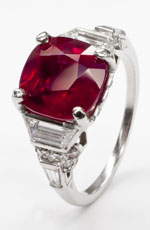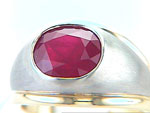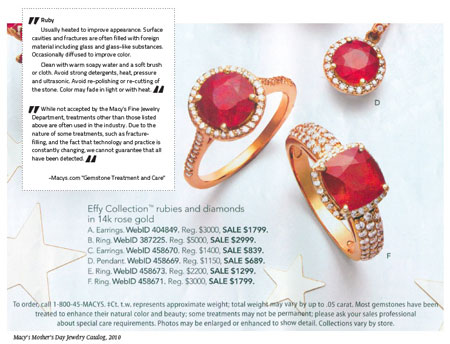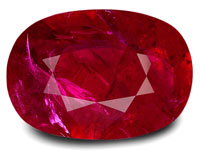 Composite Rubies-
Composite Rubies-
From bad to worse
The defendant is Macy's.
The subject is composite rubies.
The issue is disclosure.
Two lawsuits have been filed against Macy's for falsely representing the gems it sells. Gems sold as natural rubies “were in fact heavily glass filled and often heavily lead-glass treated,” said the class action suit.
Two televised sting operations, by “Good Morning America” and by San Francisco's “CBS 5,” brought public attention to the scam. On hidden cameras, jewelry department sales staff insisted the stones were ruby and required no special care. Subsequent examination by a gemologist proved them wrong.
Composite rubies are another step in increasingly flagrant gem adulterations.
It began with fracture-filling
When a gem has surface fractures, technicians may fill them with some non-gem material, such as glass. This makes the stone look better to the unaided eye, though it does not improve the stone. The gem still has fractures, and they are easily seen though a jeweler's loupe.
A fracture-filled stone is worth considerably less than a gem of similar appearance that is not fracture-filled.
What is a “composite ruby”?
You might say that a composite ruby is a fracture-filled ruby on steroids. During the past eight years, gemologists have been seeing stones with increasingly large amounts of glass. Glass fills not only surface fractures but deep cavities
Gem material may be so fractured, it could not be considered for use in jewelry if the cracks were visible. Lead glass fused into the stone hides the cracks. Some of these composite stones are more filling than ruby, the glass acting as a sort of glue holding the piece together. For more details, see our December 2007 issue.
Natural ruby is one of the hardest stones in existence, second only to diamond. A high-quality untreated ruby rivals diamond in value.
But composite rubies, being in large part glass, are fragile. As the filling deteriorates, the stones can lose their color, show cracks, and even break into pieces.
Cleaning the stones is also a delicate matter. Some jewelers report placing composite rubies into standard gem cleaning solutions and having them “dissolve like Pop Rocks”-and having the owners blame jewelers for the damage. Composites can even be harmed by ordinary household products like lemon juice and strong detergents.
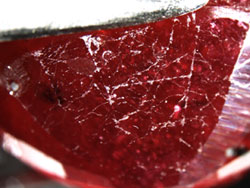 Glass filling breaks down Photomicrograph by Christopher P. Smith of AGL |
There may also be health and safety issues associated with the lead content. In a separate investigation of Macy's rubies, the San Francisco Public Press had its purchases tested for lead, which is used to improve the visual properties of glass. All the composite rubies showed significant lead content. Some appraisers and others in the jewelry industry are working to get the FTC to ban from gems and jewelry, as it is from other consumer products.
Disclosure
Industry lawyers and the Jewelers Vigilance Committee concluded years ago that the ruby composites cannot legally be sold as rubies or precious gems under FTC Guidelines. In 2007 a consortium of international gemological labs decided the stones should be called “ruby-glass composites.”
Gemologist Antoinette Matlins, author of Jewelry & Gems: The Buying Guide, suggests a completely different word - rubaire. “It's a ruby with a lot of air filled with glass,” she says. “Call it whatever you want, and charge $10 or $20 for it in the costume-jewelry aisle.”
But Macy's was calling it ruby and charging for ruby. Its website said, “Due to the nature of some treatments, such as fracture-filling, and the fact that technology and practice is constantly changing, we cannot guarantee that all have been detected.”
In fact, the independent gemologist hired by Macy's West to oversee the quality of gems it received for sale did detect treatments and repeatedly warned the company about the composite rubies it was buying. The store ignored his recommendations to reject the goods or to disclose their true nature to customers. He said, “All they wanted to talk about was how they could glamorize the product.”
Composite rubies were not the only deceit at the jewelry counter. According to the lawsuit, the store also represented heated quartz as “green amethyst” (purple amethyst is the only kind there is), black sapphires as black diamonds, irradiated diamonds as natural black diamonds, and fracture-filled or laser-drilled diamonds as untreated stones. In all these instances, the value difference between the real thing and the substitute is immense.
Flourishing fraud
Macy's is not the only store selling treated gems without proper disclosure; it's just the one big enough to merit a class action lawsuit. If a large and reputable company thinks it can slip through such adulterated, low-quality and bogus gems, how many other sellers with a lower profile and “less to lose” are doing the same?
As gem technology advances, opportunities for fraud increase. The insurer's best protection is a detailed appraisal from an experienced appraiser who is a Graduate Gemologist and preferably a Certified Insurance Appraiser™.
FOR AGENTS & UNDERWRITERS
Keep on file all documentation for scheduled jewelry, including the sales receipt. Be sure to get a detailed appraisal, preferably on JISO 78/79, from an appraiser who is not the seller.
For rubies and other colored stones, it is essential that the appraisal be written by a gemologist experienced with colored gemstones and familiar with the current pricing, treatments and frauds. Most jewelers deal primarily with diamonds, and even a trained gemologist may have little experience with colored stones.
For ruby, all treatments other than heating should be disclosed on the appraisal. (Heat treatment may also be listed, but ruby is assumed to be heat-treated unless the appraisal specifies it has not been.)
If a gem is not treated, that should be specifically stated on the appraisal. A treated stone has only a fraction of the value of an untreated gem of similar appearance.
FOR ADJUSTERS
In damage claims, have the jewelry examined by an independent gemologist to verify the jewelry's quality and the truth of the appraisal. The exam might reveal, for example, that the stone was treated and the treatment broke down; this is damage for which the insurer is not liable.
Examine the appraisal for words such as composite, treated, fracture-filled, enhanced, synthetic, lab-grown, or other qualifying terms that suggest the stone is other than natural, untreated ruby. Treated and synthesized gems are worth a fraction of the value of natural gems of similar appearance.
Just for comparison: One source puts the wholesale value of high-quality rubies at $5,000-$12,000 per carat; rubies of lesser clarity and color at $350; and ruby composites at $1-$50.
Do not assume that if the appraisal doesn't mention treatments, the gem must be untreated; most likely, if treatment (or lack of it) is not mentioned, other information is incomplete as well.
If there are any terms on the appraisal you don't understand, consider consulting a jewelry insurance professional, to avoid serious overpayment.
©2000-2025, JCRS Inland Marine Solutions, Inc. All Rights Reserved. www.jcrs.com

